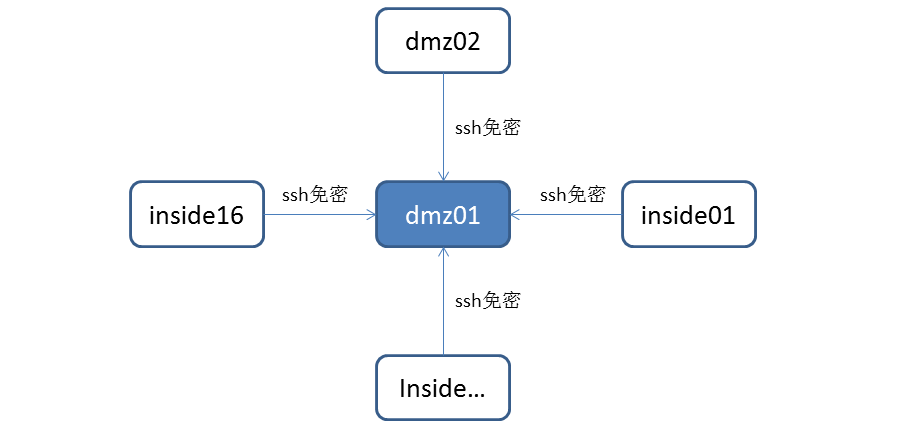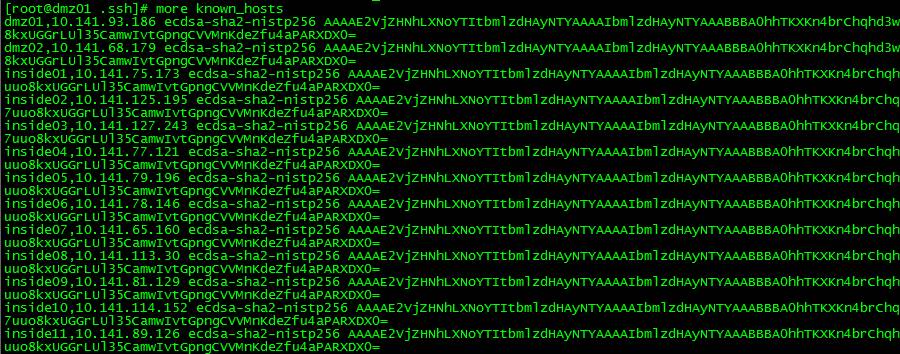How to quickly configure SSH password-free access in a Linux cluster

In daily life, whether in a test environment or a production environment, when installing and configuring multiple servers (clusters), it is often necessary to set up password-free SSH access to servers in the cluster. For example, the installation and configuration of clusters such as Hadoop and HBase, or multiple servers that require SSH password-free configuration to facilitate subsequent operation and maintenance.
Based on the recent process of building a test environment, let’s explain how to quickly configure password-free mutual SSH access to multiple servers. It is mainly divided into several steps: modify the host name, configure the secret key of the aggregation server, aggregate the secret keys of other servers, copy the aggregation key file, generate the know_hosts file, and copy the know_hosts file.
1. Cluster planning
|
Host IP |
Host name |
|
10.141.93.101 |
dmz01 |
|
10.141.93.102 |
dmz02 |
|
10.141.93.103 |
inside01 |
|
10.141.93.104 |
inside02 |
|
10.141.93.105 |
inside03 |
|
10.141.93.106 |
inside04 |
|
10.141.93.107 |
inside05 |
|
10.141.93.108 |
inside06 |
|
10.141.93.109 |
inside07 |
|
10.141.93.110 |
inside08 |
|
10.141.93.111 |
inside09 |
|
10.141.93.112 |
inside10 |
|
10.141.93.113 |
inside11 |
|
10.141.93.114 |
inside12 |
|
10.141.93.115 |
inside13 |
|
10.141.93.116 |
inside14 |
|
10.141.93.117 |
inside15 |
|
10.141.93.118 |
inside16 |
The cluster has a total of 18 servers, divided into 2 servers in the DMZ area and 16 servers in the INSIDE area. Mainly used for web servers and application servers, databases, caches, etc. In order to facilitate the deployment of applications and management of cluster servers, 18 servers are configured for password-free SSH mutual access.
2. Modify the host name
Regardless of the initial installation of the system or cloud host, the host name "localhost" or "VM_75_173_centos" cannot easily distinguish the server function. Therefore, it is easy to install, deploy, and maintain, and the host name will be re-modified.
To modify the host name, use the following command:
hostnamectl set-hostname inside01
Use the above command to modify the host name and log in again via ssh. You will see that the host name has been modified.
3. Configure the aggregation server secret key
The so-called aggregation server here is a server in the selected cluster, and then other servers perform SSH with it without password trust. This article selects dmz01 (10.141.93.101) as the aggregation server. The relationship diagram is as follows:

Other servers perform password-free trust configuration for SSH login to dmz01. Here dmz01 is the aggregation server.
The command to configure the aggregation server secret key is as follows:
[root@dmz01 ~]#ssh-keygen -t rsa
Generating public/private rsa key pair.
Enter file in which to save the key (/root/.ssh/id_rsa): [Enter key]
Enter passphrase (empty for no passphrase): [Enter key]
Enter same passphrase again: [Enter key]
Your identification has been saved in /root/.ssh/id_rsa.
Your public key has been saved in /root/.ssh/id_rsa.pub.
The key fingerprint is:
43:0d:08:18:ec:9e:d6:1f:ea:5f:04:30:0f:66:26:41 root@dmz01
The key's randomart image is:
--[ RSA 2048]----
| oE O. .. |
| o= =. o |
| . o . . |
| . |
| . o S |
| . .. . |
| . o .. |
| . .. |
| ....
------------------Enter the "/root/.ssh" directory, copy and generate the "authorized_keys" file, use the following command:
cat id_rsa.pub >> authorized_keysThe results are as follows:
[root@inside01 .ssh]# ll
total 12
-rw-r--r-- 1 root root 395 Nov 12 16:25 authorized_keys
-rw------- 1 root root 1675 Nov 12 16:24 id_rsa
-rw-r--r-- 1 root root 395 Nov 12 16:24 id_rsa.pub
4. Copy other server keys
After configuring the aggregation server secret key in Section 3, you need to configure the secret keys of 17 servers including dmz02, inside01,..., inside16. The method is the same as the command in Section 3.
After configuring the secret keys of the other 17 servers, you need to copy the secret keys of the 17 servers to the aggregation server dmz01. The copy command is as follows:
[root@inside01 .ssh]# ssh-copy-id -i dmz01
5. Copy the aggregation key file
Copy the aggregated key files from the aggregation server to the "/root/.ssh" directory of the other 17 servers. The command is as follows:
[root@dmz01 .ssh]# scp authorized_keys dmz02:/root/.ssh/As shown above, perform scp copy of the secret key file "authorized_keys". This process requires entering a password.[root@dmz01 .ssh]# scp authorized_keys inside01:/root/.ssh/
…
[root@dmz01 .ssh]# scp authorized_keys inside16:/root/.ssh/
root@inside16's password:
authorized_keys 100% 7104 6.9KB/s 00:00
Ssh password-free authentication:
[root@dmz01 .ssh]# ssh dmz02The authenticity of host 'dmz02 (10.141.68.179)' can't be established.
ECDSA key fingerprint is 22:49:b2:5c:7c:8f:73:56:89:29:8a:bd:56:49:74:66.
Are you sure you want to continue connecting (yes/no)? yes
Warning: Permanently added 'dmz02,10.141.68.179' (ECDSA) to the list of known hosts.
Last login: Sat Nov 12 17:19:19 2016 from 10.141.93.186
As can be seen from the above, "ssh dmz02", when ssh logs in to the dmz02 server, there is no need to enter a password. But it prompts that dmz02 needs to be added to the "know hosts" list file of dmz01. In this way, the next time you access dmz02 via ssh, you will no longer be prompted to add to the know hosts list.
6. Generate know_hosts file
Ssh the other 17 servers from the aggregation server in sequence, and go through the previous password-free settings. There is no need to enter a password, but there are prompts to join the know hosts list.
Note: In order to add your own dmz01 to the know hosts file, you also need to type "[root@dmz01.ssh]# ssh dmz01".
The content of the finally generated know_hosts file is as follows:

View the number of lines in the know_hosts file:
[root@dmz01 .ssh]# wc -l known_hosts
18 known_hosts
You can see one line for each host, indicating that dmz01 knows all 18 servers including itself.
7. Copy the know_hosts file
After Section 6, generate the know host settings of 18 servers for dmz01, and copy the /root/.ssh/know_hosts file scp of dmz01 to the other 17 servers.
SSH password-free login verification:
[root@dmz01 .ssh]# ssh inside10
Last login: Tue Nov 15 15:01:18 2016 from 10.141.93.186
[root@inside10 ~]# ssh inside15
Last login: Sat Nov 12 17:52:29 2016 from 10.141.93.186
[root@inside15 ~]# ssh dmz02
Last login: Sat Nov 12 20:05:59 2016 from 10.141.93.186
[root@dmz02 ~]# ssh dmz01
Last login: Thu Nov 17 23:56:05 2016 from 218.10.89.246
[root@dmz01 ~]# ssh inside15
Last login: Fri Nov 18 00:23:54 2016 from 10.141.114.152
Ssh password-free login sequence: dmz01àinside10àinside15àdmz02àdmz01àinside15.
8. Summary
This article mainly involves the following commands:
hostnamectl set-hostname inside01
ssh-keygen -t rsa
ssh-copy-id -i dmz01
That’s it for this article. I hope you will support this site in the future.
The above is the detailed content of How to quickly configure SSH password-free access in a Linux cluster. For more information, please follow other related articles on the PHP Chinese website!

Hot AI Tools

Undresser.AI Undress
AI-powered app for creating realistic nude photos

AI Clothes Remover
Online AI tool for removing clothes from photos.

Undress AI Tool
Undress images for free

Clothoff.io
AI clothes remover

Video Face Swap
Swap faces in any video effortlessly with our completely free AI face swap tool!

Hot Article

Hot Tools

Notepad++7.3.1
Easy-to-use and free code editor

SublimeText3 Chinese version
Chinese version, very easy to use

Zend Studio 13.0.1
Powerful PHP integrated development environment

Dreamweaver CS6
Visual web development tools

SublimeText3 Mac version
God-level code editing software (SublimeText3)

Hot Topics
 What computer configuration is required for vscode
Apr 15, 2025 pm 09:48 PM
What computer configuration is required for vscode
Apr 15, 2025 pm 09:48 PM
VS Code system requirements: Operating system: Windows 10 and above, macOS 10.12 and above, Linux distribution processor: minimum 1.6 GHz, recommended 2.0 GHz and above memory: minimum 512 MB, recommended 4 GB and above storage space: minimum 250 MB, recommended 1 GB and above other requirements: stable network connection, Xorg/Wayland (Linux)
 vscode cannot install extension
Apr 15, 2025 pm 07:18 PM
vscode cannot install extension
Apr 15, 2025 pm 07:18 PM
The reasons for the installation of VS Code extensions may be: network instability, insufficient permissions, system compatibility issues, VS Code version is too old, antivirus software or firewall interference. By checking network connections, permissions, log files, updating VS Code, disabling security software, and restarting VS Code or computers, you can gradually troubleshoot and resolve issues.
 How to run java code in notepad
Apr 16, 2025 pm 07:39 PM
How to run java code in notepad
Apr 16, 2025 pm 07:39 PM
Although Notepad cannot run Java code directly, it can be achieved by using other tools: using the command line compiler (javac) to generate a bytecode file (filename.class). Use the Java interpreter (java) to interpret bytecode, execute the code, and output the result.
 What is vscode What is vscode for?
Apr 15, 2025 pm 06:45 PM
What is vscode What is vscode for?
Apr 15, 2025 pm 06:45 PM
VS Code is the full name Visual Studio Code, which is a free and open source cross-platform code editor and development environment developed by Microsoft. It supports a wide range of programming languages and provides syntax highlighting, code automatic completion, code snippets and smart prompts to improve development efficiency. Through a rich extension ecosystem, users can add extensions to specific needs and languages, such as debuggers, code formatting tools, and Git integrations. VS Code also includes an intuitive debugger that helps quickly find and resolve bugs in your code.
 Can vscode be used for mac
Apr 15, 2025 pm 07:36 PM
Can vscode be used for mac
Apr 15, 2025 pm 07:36 PM
VS Code is available on Mac. It has powerful extensions, Git integration, terminal and debugger, and also offers a wealth of setup options. However, for particularly large projects or highly professional development, VS Code may have performance or functional limitations.
 How to use VSCode
Apr 15, 2025 pm 11:21 PM
How to use VSCode
Apr 15, 2025 pm 11:21 PM
Visual Studio Code (VSCode) is a cross-platform, open source and free code editor developed by Microsoft. It is known for its lightweight, scalability and support for a wide range of programming languages. To install VSCode, please visit the official website to download and run the installer. When using VSCode, you can create new projects, edit code, debug code, navigate projects, expand VSCode, and manage settings. VSCode is available for Windows, macOS, and Linux, supports multiple programming languages and provides various extensions through Marketplace. Its advantages include lightweight, scalability, extensive language support, rich features and version
 Linux Architecture: Unveiling the 5 Basic Components
Apr 20, 2025 am 12:04 AM
Linux Architecture: Unveiling the 5 Basic Components
Apr 20, 2025 am 12:04 AM
The five basic components of the Linux system are: 1. Kernel, 2. System library, 3. System utilities, 4. Graphical user interface, 5. Applications. The kernel manages hardware resources, the system library provides precompiled functions, system utilities are used for system management, the GUI provides visual interaction, and applications use these components to implement functions.
 What is the main purpose of Linux?
Apr 16, 2025 am 12:19 AM
What is the main purpose of Linux?
Apr 16, 2025 am 12:19 AM
The main uses of Linux include: 1. Server operating system, 2. Embedded system, 3. Desktop operating system, 4. Development and testing environment. Linux excels in these areas, providing stability, security and efficient development tools.






